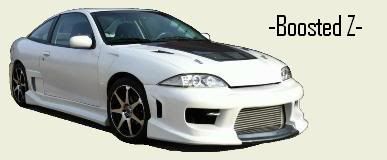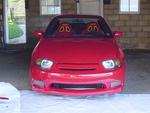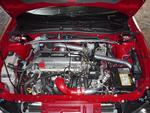I've been getting a lot of IM's lately about how to hook up this or that, where X part goes or how to connect up vacuum lines. So here you guys go, I think its pretty self explainatory.
Pink lines are vacuum lines
Green line is a fuel feed line
Red line is a fuel return line
Grey box with black outline is the wastegate
Grey box with no outline is a check valve
Green lookin thing on the top left is the boost controller valve, which doesn't need to be there if you don't have a boost controller.

If you notice anything I forgot, let me know and I'll add it.
 4cyltuner.com
4cyltuner.com - Information Source For 4 Cylinder Tuners
Buy stuff from CarCustoms Ebay! Won't be disappointed!
Nice!
The BOV can go on the hot side or the cold side of the intercooler. Each has advantages and disadvantages though.
The hot side advantage is that you're venting hot air, instead of air that's been through the IC (disadvantage of cold side). The disadvantage of the hot side is slower BOV response and more chance for compressor surge.

-
Interior FAQ -
J-Body of Michigan -
thats very helpful. thank you

Raptor what size is your intercooler
great diagram, wonder if we can sticky it.

<a href="http/www.cardomain.com/id/stevefire23">stevefire23</a>
Raptor wrote:Nice!
The BOV can go on the hot side or the cold side of the intercooler. Each has advantages and disadvantages though.
The hot side advantage is that you're venting hot air, instead of air that's been through the IC (disadvantage of cold side). The disadvantage of the hot side is slower BOV response and more chance for compressor surge.
nope, you've got that backwords. the closer the bov is the the compressor (hot side) the less chance there is to get compressor surge. responce should be the same. only reason it might be diff is due to a slightly longer vac line, but in most setups it could actually be a shorter line. and either way, its not large enough of a id line to make any real diff in response by adding an extra foot of line.

12.6 @ 114.6 MPH
Bluntly, compressor surge is caused by waves of air coming back through the charge piping and smacking against the compressor fins.
Venting the air as near the TB as possible (BOV on cold side) reduces the power & amount of these waves caused when the TB slams shut, which results in less chance of compressor surge.
That's how I see it, anyway. I don't have flow charts or anything to back it up, but that's what image makes sense to me.

-
Interior FAQ -
J-Body of Michigan -
Why would you put the check valve on the FMU?? It will not see positive pressure??
I put it on the MAP sensor.
colt side right by the Throttle for the BOV, that is how I run it
Best time:"""11.946""" @ 114.73 mph @17psi 1.83--60"
11 second daily driver!!!!
Race Related 727-561-9440
Shop of choice for your 11 second J body!
Also, built bottom end and or top end LSJ and L61's available.
13's

----12's

----11's


----10's

I've always understood it too that the BOV should be as close as possible to the TB. That way when the butterfly plate closes the serge back doesn't have very far to go before it is taken out of the system. I don't think I have ever seen a setup with the BOV before the intercooler.
I'm not sure on the check valve (never ran a turbo system on my old 2.4) but I thought the whole point was so that the MAP doesn't see boost. If that is the case then it should be inline with the MAP sensor so that it can bleed off the boost before the MAP sees it.

Quoth the Raven 'Nevermore
raven@accesswave.ca
Raven Autosports
55 McQuade Lake Cres,
Halifax, Nova Scotia, Canada
(902) 850-3330
10.82@132
^^^Exactly
My BOV is right before the TB also.


SunCavi_L61T wrote:Why would you put the check valve on the FMU?? It will not see positive pressure??
I put it on the MAP sensor.
colt side right by the Throttle for the BOV, that is how I run it
I based the diagram off my Cartech FMU, which requires a check valve on a nipple provided specifically for the check valve. I don't believe you would put a check valve on most other FMU's, and yes, you put one on the MAP sensor. Although there are those who get away with no check valve on the MAP at all.
 4cyltuner.com
4cyltuner.com - Information Source For 4 Cylinder Tuners
Buy stuff from CarCustoms Ebay! Won't be disappointed!
yes, reading that diagram I understood the check valve to be for the cartech.
I wonder if that should be included at all, because it is sort of a 'special case' of only people who use the cartech.
as for the BOV, I think the closer to the TB the better.
like I said, great diagram.

<a href="http/www.cardomain.com/id/stevefire23">stevefire23</a>
raven wrote:I don't think I have ever seen a setup with the BOV before the intercooler.
I've seen a few OEM cars come with it, but I can't think of any off the top of my head at the moment.
Oh, and there's
mine.


-
Interior FAQ -
J-Body of Michigan -
The stock MAP sensor is a one bar MAP. The output voltage ranges from 0-5, the higher the volts, the less vacuum you have. Once you enter boost, the MAP is maxed out at 5 volts, and that's it. It can't go any higher than that.
I never used a check valve setup.
O noes!
over pressuring a sensor is never a good idea...
a 1 bar sensor is just that...
calibrated to approx 0psig.
some sensors are rated for an allowable over pressure and a burst pressure...
(industrial sensors that is)
good luck finding those specs?
......................................................................................................................
"forcast for tomorrow... a few sprinkles of genius and a chance of doom"

Where is the chech valve located or does the a car come with one
This is my last question about them but do you have to have one with a turbo kit?
Sometimes yes, sometimes no. Some people get away without them, some can't get thier cars to run right unless they put one on. They are incredibly cheap, so its not like it would be keeping you from buying a kit (like $.50 each).
 4cyltuner.com
4cyltuner.com - Information Source For 4 Cylinder Tuners
Buy stuff from CarCustoms Ebay! Won't be disappointed!


















